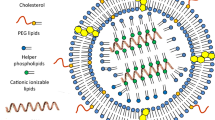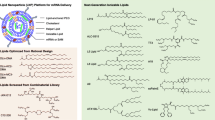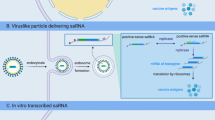Abstract
Purpose. To prepare poly(lactide-co-glycolide)(PLGA) microspheres containing recombinant hepatitis B core antigen (HBcAg; Mw = 3,600,000) by a w/o/w emulsion/solvent evaporation method and evaluate the possibility of this system as a potent long-acting carrier for hepatitis B core antigen in mice.
Methods. Various additives had been incorporated in the internal aqueous phase during the process of microencapsulating HBcAg, HBcAg antigenicity in the medium extracted from the prepared microspheres were measured by ELISA. Shape confirmation of the HBcAg antigen was performed by a sucrose gradient velocity centrifugal technique. For in vivo study, prepared microspheres were administered subcutaneously to Balb/C mice, and the serum IgG level was determined by ELISA.
Results. The inactivation of HBcAg by methylene chloride was dramatically reduced by the addition of gelatin (4−8% (w/v)) to the internal aqueous phase during the preparation. Further improvement of the loading efficiency to almost 61% resulted with cooling (4°C). The prepared microspheres (4.27 μm ± 1.23 μm) containing 0.15% HBcAg displayed burst release (50−60% within 2 days). In subcutaneous inoculation, the adjuvant effect of PLGA microspheres was almost the same as that of the complete Freund's adjuvant. Whereas oral inoculation using the microspheres was not effective.
Conclusions. The pH of the added gelatin seemed to be the key to the stabilization of HBcAg from various stability tests and CD spectrum study. Finally, the possibility of using this system as a potent long-acting hepatitis B vaccine was demonostrated.
Similar content being viewed by others
REFERENCES
J. Freund. The effect of paraffin oil and mycobacteria on antibody formation and sensitization. Am. J. Clin. Pathol. 21:645–656 (1951).
G. W. Beebe, A. H. Simon, and S. Vivona. Long-term mortality follow up of army recruits who received adjuvant influenza virus vaccine. Am. J. Epidemiol. 95:337–344 (1972)
D. T. O'Hagan, K. Palin, S. S. Davis, P. Artursson, and I. Sjoholm. Microparticles as potentially orally active immunological adjuvants. Vaccine 7:421–424 (1989).
J. H. Eldridge, C. J. Hammond, J. A. Meulbroek, J. K. Staas, R. M. Gilley, and T. R. Tice. Controlled vaccine release in the gutassociated lymphoid tissues 1. Orally administered biodegradable microspheres target in the Peyer's patches. J. Contr. Rel. 11:205–214 (1990).
T. Uchida, S. Martin, T. P. Foster, R. C. Wardley, and R. C. Grimm. Dose and load studies for subcutaneous and oral delivery of poly(lactide-co-glycolide) microspheres containing ovalbumin. Pharm. Res. 11:1009–1015 (1994).
T. Uchida and S. Goto. Oral delivery of poly(lactide-co-glycolide) microspheres containing ovalbumin as vaccine formulation: particle size study. Biol. Pharm. Bull. 17:1272–1276 (1994).
T. Uchida, S. Goto, and T. P. Foster. Particle size studies for subcutaneous delivery of poly(lactide-co-glycolide) microspheres containing ovalbumin as vaccine formulation. J. Pharm. Pharmacol. 46:1214–1221 (1995).
R. V. Nellore, P. G. Pande, D. Young, and H. R. Bhagat. Evaluation of biodegradable microspheres as vaccine adjuvant for hepatitis B surface antigen. J. Parent. Sci. & Tech. 46:176–180 (1992).
N. Nath, K. Hickman, S. Nowlan, D. Shah, J. Philips, and S. Babler. Stability of the recombinant hepatitis B core antigen. J. Clin. Microbio. 30:1617–1619 (1992).
A. Budkowska, A. Kalinowska, and A. Nowoslawski. Identification of two HBeAg subspecificities revealed by chemical treatment and enzymatic digestion of liver-derived HBcAg. J. Immunol. 123:1415–1416 (1979).
T. Uchida, A. Yagi, Y. Oda, and S. Goto. Microencapsulation of ovalbumin in poly(lactide-co-glycolide) by oil-in-oil (o/o) solvent evaporation method. J. Microencapsulation 13:509–518 (1996).
S. Benita, J. P. Benoit, F. Puisieux, and C. Thies. Characterization of drug loaded poly (dl-lactide) microspheres. J. Contr. Rel. 73:1721–1724 (1984).
P. Edman, E. Bjork, and L. Ryden. Microspheres as a nasal delivery system for peptide drugs. J. Contr. Rel. 21:165–172 (1993).
T. Heya, H. Okada, Y. Tanigawara, Y. Ogawa, and H. Toguchi. Effects of counteranion of TRH and loading amount on control of TRH release from copoly (dl-lactic/glycolic acid) microspheres prepared by an in-water drying method. Int. J. Pharm. 69:69–75 (1991).
Y.-L. Lai, R. C. Mehata, A. A. Thacker, S.-D. Yoo, P. J. McNamara, and P. P. DeLuca. Sustained bronchodilation with isoproterenol poly(glycolide-co-lactide) microspheres. Pharm. Res. 10:119–125 (1993).
Y. Ogawa, Y. M. Yamamoto, S. Takada, H. Okada, and T. Shimamoto. Controlled-release of leuprolide acetate from polylactic acid or copoly(lactic/glycolic) acid microcapsules: influence of molecular weight and copolymer ratio of polymer. Chem. Pharm. Bull. 36:1095–1103 (1988).
P. G. Jani, W. Halbert, J. Langridge, and A. T. Florence. The uptake and translocation of latex nonospheres and microspheres after oral administration to rats. J. Pharm. Pharmacol. 41:809–812 (1989).
Author information
Authors and Affiliations
Rights and permissions
About this article
Cite this article
Uchida, T., Shiosaki, K., Nakada, Y. et al. Microencapsulation of Hepatitis B Core Antigen for Vaccine Preparation. Pharm Res 15, 1708–1713 (1998). https://doi.org/10.1023/A:1011904627929
Issue Date:
DOI: https://doi.org/10.1023/A:1011904627929




